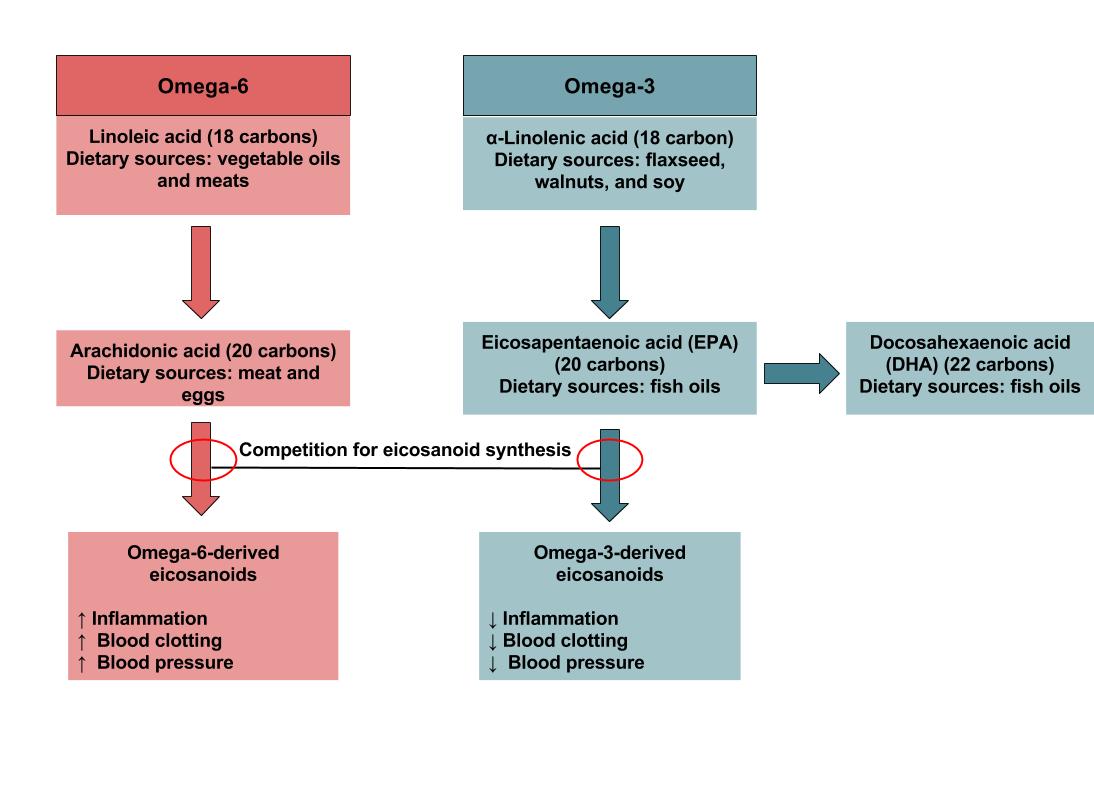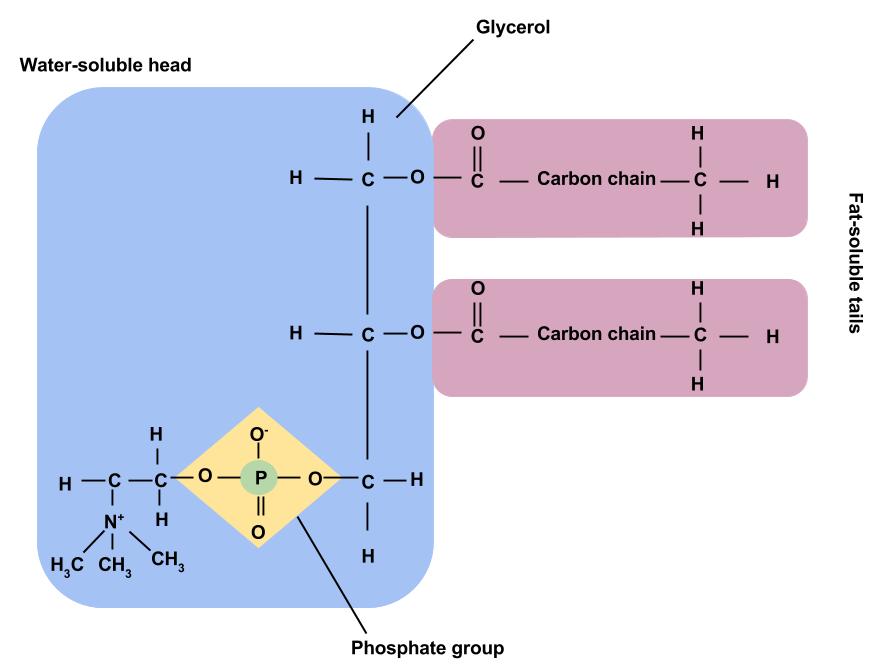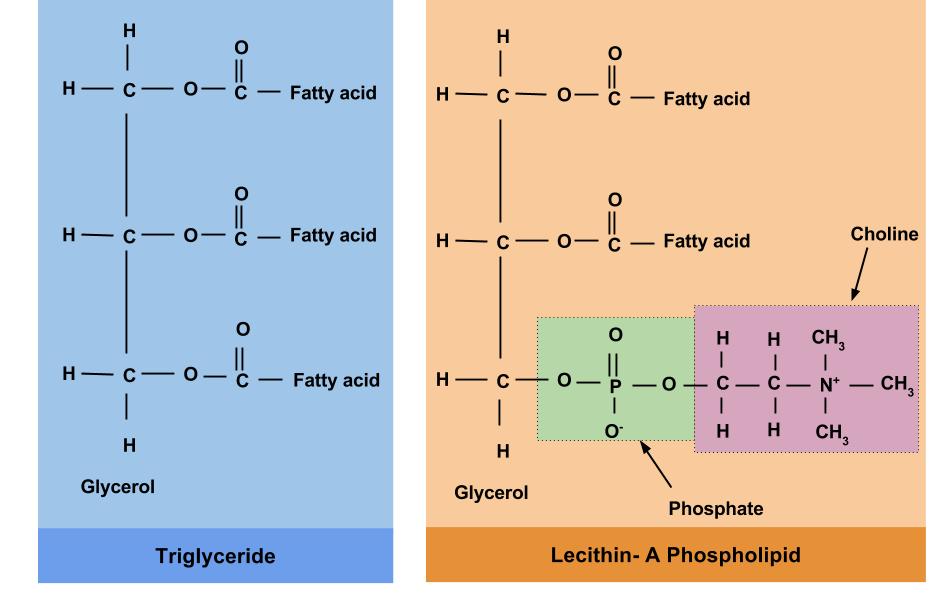5.5: Nonessential and Essential Fatty Acids
- Page ID
- 40596
Fatty acids are vital for the normal operation of all body systems. The circulatory system, respiratory system, integumentary system, immune system, brain, and other organs require fatty acids for proper function. The body is capable of synthesizing most of the fatty acids it needs from food. These fatty acids are known as nonessential fatty acids. However, there are some fatty acids that the body cannot synthesize and these are called essential fatty acids. It is important to note that nonessential fatty acids doesn’t mean unimportant; the classification is based solely on the ability of the body to synthesize the fatty acid.
Essential fatty acids must be obtained from food. They fall into two categories—omega-3 and omega-6. The 3 and 6 refer to the position of the first carbon double bond and the omega refers to the methyl end of the chain. Omega-3 and omega-6 fatty acids are precursors to important compounds called eicosanoids. Eicosanoids are powerful hormones that control many other hormones and important body functions, such as the central nervous system and the immune system. Eicosanoids derived from omega-6 fatty acids are known to increase blood pressure, immune response, and inflammation. In contrast, eicosanoids derived from omega-3 fatty acids are known to have heart-healthy effects. Given the contrasting effects of the omega-3 and omega-6 fatty acids, a proper dietary balance between the two must be achieved to ensure optimal health benefits.
Essential fatty acids play an important role in the life and death of cardiac cells, immune system function, and blood pressure regulation. Docosahexaenoic acid (DHA) is an omega-3 essential fatty acid shown to play important roles in synaptic transmission in the brain during fetal development.
Some excellent sources of omega-3 and omega-6 essential fatty acids are fish, flaxseed oil, hemp, walnuts, and leafy vegetables. Because these essential fatty acids are easily accessible, essential fatty acid deficiency is extremely rare.
 Figure \(\PageIndex{1}\): Essential Fatty Acids. Image by Allison Calabrese / CC BY 4.0
Figure \(\PageIndex{1}\): Essential Fatty Acids. Image by Allison Calabrese / CC BY 4.0
Phospholipids
Like triglycerides, phospholipids have a glycerol backbone. But unlike triglycerides, phospholipids are diglycerides (two fatty-acid molecules attached to the glycerol backbone) while their third fatty-acid chain has a phosphate group coupled with a nitrogen-containing group. This unique structure makes phospholipids water soluble. Phospholipids are what we call amphiphilic—the fatty-acid sides are hydrophobic (dislike water) and the phosphate group is hydrophilic (likes water).
In the body phospholipids bind together to form cell membranes. The amphiphilic nature of phospholipids governs their function as components of cell membranes. The phospholipids form a double layer in cell membranes, thus effectively protecting the inside of the cell from the outside environment while at the same time allowing for transport of fat and water through the membrane.
 Figure \(\PageIndex{2}\): The Structure of a Phospholipid. Image by Allison Calabrese / CC BY 4.0
Figure \(\PageIndex{2}\): The Structure of a Phospholipid. Image by Allison Calabrese / CC BY 4.0
Phospholipids are ideal emulsifiers that can keep oil and water mixed. Emulsions are mixtures of two liquids that do not mix. Without emulsifiers, the fat and water content would be somewhat separate within food. Lecithin (phosphatidylcholine), found in egg yolk, honey, and mustard, is a popular food emulsifier. Mayonnaise demonstrates lecithin’s ability to blend vinegar and oil to create the stable, spreadable condiment that so many enjoy. Food emulsifiers play an important role in making the appearance of food appetizing. Adding emulsifiers to sauces and creams not only enhances their appearance but also increases their freshness.
Lecithin’s crucial role within the body is clear, because it is present in every cell throughout the body; 28 percent of brain matter is composed of lecithin and 66 percent of the fat in the liver is lecithin. Many people attribute health-promoting properties to lecithin, such as its ability to lower blood cholesterol and aid with weight loss. There are several lecithin supplements on the market broadcasting these claims. However, as the body can make most phospholipids, it is not necessary to consume them in a pill. The body makes all of the lecithin that it needs.
 Figure \(\PageIndex{3}\): The Difference Between Triglycerides and Phospholipids. Image by Allison Calabrese / CC BY 4.0
Figure \(\PageIndex{3}\): The Difference Between Triglycerides and Phospholipids. Image by Allison Calabrese / CC BY 4.0
Sterols
Sterols have a very different structure from triglycerides and phospholipids. Most sterols do not contain any fatty acids but rather multiring structures. They are complex molecules that contain interlinking rings of carbon atoms, with side chains of carbon, hydrogen, and oxygen attached. Cholesterol is the best-known sterol because of its role in heart disease. It forms a large part of the plaque that narrows the arteries in atherosclerosis. In stark contrast, cholesterol does have specific beneficial functions to perform in the body. Like phospholipids, cholesterol is present in all body cells as it is an important substance in cell membrane structure. Approximately 25 percent of cholesterol in the body is localized in brain tissue. Cholesterol is used in the body to make a number of important things, including vitamin D, glucocorticoids, and the sex hormones, progesterone, testosterone, and estrogens. Notably, the sterols found in plants resemble cholesterol in structure. However, plant sterols inhibit cholesterol absorption in the human body, which can contribute to lower cholesterol levels.
Although cholesterol is preceded by its infamous reputation, it is clearly a vital substance in the body that poses a concern only when there is excess accumulation of it in the blood. Like lecithin, the body can synthesize cholesterol.
 Figure \(\PageIndex{4}\): The Structure of Cholesterol. “Cholesterol Chemical Structure” by Wesalius / Public Domain
Figure \(\PageIndex{4}\): The Structure of Cholesterol. “Cholesterol Chemical Structure” by Wesalius / Public Domain


